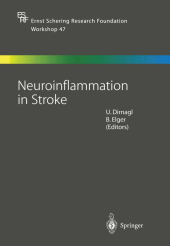 Neuerscheinungen 2014Stand: 2020-02-01 |
Schnellsuche
ISBN/Stichwort/Autor
|
Herderstraße 10
10625 Berlin
Tel.: 030 315 714 16
Fax 030 315 714 14
info@buchspektrum.de |

Ulrich Dirnagl, Bernd Elger
(Beteiligte)
Neuroinflammation in Stroke
Herausgegeben von Dirnagl, Ulrich; Elger, Bernd
Softcover reprint of the original 1st ed. 2004. 2014. xii, 224 S. 40 SW-Abb., 1 Farbabb., 9 Tabellen. 2
Verlag/Jahr: SPRINGER, BERLIN; SPRINGER 2014
ISBN: 3-662-05428-0 (3662054280)
Neue ISBN: 978-3-662-05428-4 (9783662054284)
Preis und Lieferzeit: Bitte klicken
Stroke is a major cause of death and disability in industrialized countries. To date, the medical need of efficient therapy for this de vastating cerebrovascular disorder remains unmet. During the last decades, the development of pharmacological stroke therapies was aimed at improving patient outcome by restoration of cerebral blood flow or protection from acute neuronal cell death. Almost all of The participants of the workshop VI Preface these appraaches targeted the very early events after vascular occIu sion. However, primarily for logistical reasons, only a small portion of strakes can be treated within 6-10 h after the insult. In recent years it has been recognized that strake pathophysiology is a dynamic pracess, and that delayed pracesses, which occur dur ing the days and weeks following arterial occIusion, may lead to further deterioration or to impairment of recovery and rehabilitation in subacute and chranic stages. Evidence is accumulating that neu rainflammation is a major player in these delayed pathophysiologi cal pracesses. While some components of neurainflammation such as removal of cell debris and release of traphic factors may support recovery pracesses, others such as the generation of free radicals and other cytotoxic mediators are deleterious for brain tissue after isch emia. Thus, neurainflammation after strake can be considered a dou ble-edged sword, having potentially both detrimental and beneficial effects. As in other inflammatory reactions in the body, the cellular and humoral interactions are highly complex in the setting of neu rainflammation.
G.A. Rosenberg, Sh. Mun-Bryce: Matrix Metalloproteinases in Neuroinflammation and Cerebral Ischemia; H. Wolburg et al: Involvement of Tight Junctions During Transendothelial Migration of Mononuclear Cells in Experimental Autoimmune Encephalomyelitis; St. Allan, Ch. Stock: Cytocines in Stroke; J.Van Beek: Complement Activation: Beneficial and Detrimal Effects in the CNS; U.Dirnagl: Inflammation in Stroke: The Good, the Bad and the Unknown; J. Koistinaho et al: Tetracycline Derivatives as Anti-Inflammatroy Agents and Potential Agents in Stroke Treatment; M. Spatz et al.: Induction of Mucosal Tolerance to E-selection Targets Immunomodulation to Activating Vessel Segments and Prevents Ischemic and Hemorrhagic Stroke; M. Schwartz: Protective Autoimmunity and T-cell Mediated Neuroprotection; G.J. del Zoppo: Lessons from Stroke Trials Using Anti-Inflammatory Approaches that have Failed; A. Chamorro, A.M. Planas: Inflammation-mediated Damage as Potential Therapeutic Target in Acute Ischemic Stroke; M. Schwaninger et al.: Design Issues in Selected Recent or Ongoing Stroke Trials;


